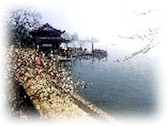| back  photo1 photo1
 photo2 photo2
 photo3 photo3
|
A city of eastern
China at the head of Hangzhou Bay, an inlet of the East China Sea. Founded in 606,
the city was the capital of a powerful kingdom from 907 to 960. It was later described by
Marco Polo as one of the finest and noblest cities in the world. Today it is a modern
industrial center and the capital of Zhejiang province. Population, 1,250,000.  West lake West lake
The lake lies to the west of the city, thus its name. The lake is surrounded by mountains
on three sides and the city on the fourth. It boasts numerous historic and scenic spots.
Pagoda of Six Harmonies
First built in 976AD, is famed in the region south of the Yangtze River for its sheer side
as a brick-and-wood structure. It is a representative masterpiece of ancient Chinese
architecture. This 59.89-metre-tall octagonal structure has seven storeys, although it has
the appearance of a thirteeen-floor building. The top floor of the pagoda provides a
panoramic view of the rough-and-tumble Qiantang River.
Lingyin(Soul's Retreat) Temple
First built in 326 AD, The 33.6-metre-high Mahavira Hall, the centrepiece of the temple,
is the tallest of all Chinese buildings with a single-layered roof and double eaves.
Enshrined in the hall is a 19.6-metre-tall statue of Sakyamuni sitting cross-legged on a
five-metre-tall lotus pedestal. The statue is formed with 24 pieces of camphorwood, and
the pedestal is fashioned out of a single trunk of camphorwood. As a sanctuary of 330-odd
stone carvings and sculptures wrought during the Five Dynasties and the Song and Yuan
dynasties, the Feilai Peak(Peak that flew Here) in front of the Lingyinshi figures
prominently in ancient Chinese plastic art history.
China Tea Museum
The entire Chinese tea history is presented in a graphic way through the museum's five
pavilions which display the tea-related history, varieties of tea, tea sets, drinking
services, and tea-related customs and habits.
China Silk Museum
The China Silk Museum, a national institution at a rather high professional level, sits by
the West Lake with a floorspace of 10,000 square metres. The museum consists of the
Pavilion of Introduction, Pavilion of Sericulture, Pavilion of Silk Reeling, Pavilion of
Silks, Pavilion of dyeing, and Pavilion of Miscellaneous Topics, which combine to tell an
authentic story about the vicissitudes of Chinese silk industry over the last 5,000 years.
The museum is also complete with a department store, trade negotiation rooms and a fashion
show center.
Yellow Dragon Culture Village
The elegant park imitating Song Dynasty style. Performers, sales clerks, waiters and
waitresses all wear the costume of the Song Dynasty.
Chinese Medicine Museum
It is only appropriate for China's only museum of traditional Chinese medicinal herbs to
be housed in the ancient buildings of a venerated pharmacy, Hu Qingyu's Hall. The museum
acquaints visitors with the history of traditional Chinese medicinal herbs-their origin,
formation, development, application, effect, and their position in Chinese and world
medical history. Samples are on display, and in a workshop herbs are prepared for medical
use. The reception hall is aptly named "Xingqutang", or Hall for Those Who Are
Interested.
(back)
|
 West lake
West lake